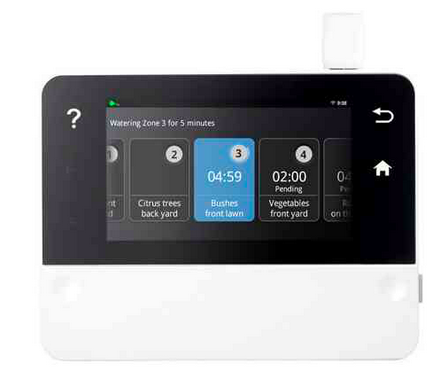

by Larry Magid
On a rare San Francisco Bay Area rainy day, I drove by a house whose automatic sprinkler system was watering the lawn, even though water was falling from the sky. It’s a colossal waste at a time when California is suffering from a four-year drought.
Thanks to the Rain Machine, that can no longer happen at my house. To begin with, we no longer have a lawn. Our front yard looks more like a forest thanks to a big redwood tree and, as to our backyard lawn, we’ve embraced “brown is the new green.” But we do have plenty of vegetables, flowers, potted plants and fruit trees which need to be watered.
We’ve long had an automated sprinkler system but it was pretty dumb. It knew when to water and for how long but had no idea about weather conditions. So, it, along with our grass, is now history. I’ve replaced it with an Internet-connected timer that adjusts whether or how much it waters based on reports from The National Oceanic and Atmospheric Administration (NOAA). I also had a guy take out the sprinklers and install a drip system that delivers water directly to the trees and plants that need it.
Like nearly all automatic watering systems you can set start time and duration for each zone but whether and for how long the watering takes place is also determined by the weather. If it’s raining it won’t water at all and if it’s humid, it may water less. It could add a bit of water if it’s very hot or very dry. It also adjusts water depending on upon the wind and the type of crop. Weather data is based on your specific location – down to about a 1.6 mile area.
Initial setup is also easy, especially if you’re replacing an existing controller. Just take the wires out of the old timer and connect them to the new one. The controller, which is based on Android software, requires you to enter your WiFi password on the console itself and then download the app to an iOS or Android phone or tablet. There are also some basics things you can do from the Rain Machine console itself such as manually watering your garden. The console will also give you a weather report on its LCD screen.
This device is yet another example of “the Internet of Things,” though as the company says in its marketing materials, in this case it’s the Internet of growing things.
Rain Machine is sold directly to consumers, but ArcTouch, a San Francisco app development company is working with home builder KB Home to integrate similar technology into an entire community of new homes. Adam Fingerman, the company’s Chief Experience Officer told me that he envisions healthy competition between home owners in connected communities, using his app and water controllers to see neighbors can use the least amount of water. Fingerman said that devices like the Rain Machine can save home owners between 25 to 50 gallons a day but if you can connect them to all of new homes in a community the savings could add up to “hundreds of thousands of gallons of day and over the course of an entire summer you’re getting into the millions.” He said it’s a “big deal if you can have 100 percent penetration of a particular product from day one.”